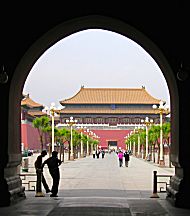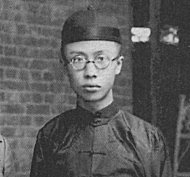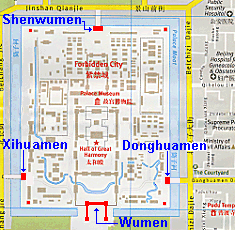The Mightiest of Them All


Wumen is both awe inspiring and imposing and its not one, but five towers earns it its nickname of Wufenglou or "Five Phoenixes". No other gate in the emperor′s city had five towers.
Even in its somewhat dilapidated state in 1900 above (blending above to 2003 SARS) it strongly radiated power and might to any visitor and envoy.
The buildings stand an impressive 35.6 meter high and are all linked by covered corridors adding to the largeness.
The center tower and the four corner towers have double eave roofs covered with yellow glazed tiles.
The center tower is 60 meters in length and 25 meters deep. The center- and flanking platforms are 12 meters high and painted in the imperial vermilion color.
Wufengmen's five buildings were matched with five entrances, three in the wall facing south and one in each of the walls facing east and west, respectively, called Zuoyemen and Youyemen.


Inside of Zouyemen
The central passageway was for the exclusive use by the emperor and the empress' phoenix sedans. The left (west) doorway was for use by officers and officials and the right (east) one for imperial relatives.
Zuoyemen and Youyemen were entrances for officers and officials when emperors ascended the throne or conducted state affairs. These two gates were also the entrances for civil- and military candidates for the court examinations. Those given odd numbers used Zuoyemen and those with even numbers Youyemen.
But there were actually some rare exceptions to the strict usage of the emperor's central passageway -see sidebar!


During the Ming Dynasty lanterns were hung on Wumen and banquets given for officials on the 15th day of the first month of the new Lunar calendar year. Also at Wumen, moon cakes were handed out at the beginning of Spring, cool puddings in Duanwu festival and flowery puddings in the Double Nine Festival. During Ming and Qing the imperial annual calendar was decreed from the gate on the first day of the 10th month.
However, also some sinister events took place in front of Wumen:
In the Ming dynasty (1368-1644) court officials were caned for their offences in front of this gate and legend has it that death penalty for senior officials was carried out here as well. This must remain a myth since it is hard to believe that the emperor would pollute this hugely symbolic gate with something as "low" as public excutions.

 />
/>
On a more positive node, triumphant celebrations of successful military campaigns were held here and prisoners paraded for the emperor.
The drawing right shows the Qing emperor in a blue robe (far right, middle) sitting on a throne in 1776 in Wumen with prisoners-of-war (far left, bottom) from battles in Sichuan Province being paraded in the courtyard in front of Wumen.
The blended photo was taken from Wumen Gate in October 2008 and shows the western side of the U-shaped structure. Note all the people milling around and awaiting their turn to visit The Forbidden City. The structure in the rear is not Tian′anmen, but Duanmen, which incidentally is an often overlooked perfect twin of Tian′anmen.
Exiting Wumen northbound offers you the beautiful scenery (photo below) of Taihemen (Gate of Supreme Harmony) with the Inner Golden Water River, also known as the "Jade Belt Canal" and its five marble bridges in the front. Unnoticed by most, the five bridges spanning the river have the same size as those spanning the Outer Golden Water River in front of Tian′anmen.


burned down 100 days after its inauguration in 1412.
Blended is the north side of Wumen during 2003 SARS
Turning 180 degrees however will show you the rarely photographed northern side of Wumen. You will clearly see not just three but five exits since both Zouyemen and Youyemen unexpectedly exit north. Horse ramps are still extant on both sides of the north side of Wuman gate as seen on photo below.
For a long time a strange twist of fate made Wumen the very center for handling all of the emperors' court affairs. When the Ming Yongle emperor in 1412 moved his seat of government from Nanjing to the yet unfinished Beijing he decreed that all court affairs be held in the three Great Halls of the Outer Court: Taihedian, Zhonghedian and Baohedian.


Note also the northern exits of Zuoyemen and Youyemen far right and far left
The older photo shows the NW corner with the western horse ramp
But less than 100 days later all three halls were struck by lightning and burned down. This was seen as an omen from Heaven and for fear of going against the will of Heaven the Yongle emperor imposed a regulation that "court affairs be handled at Wumen".
A throne facing Wumen was set inside Taihemen and the emperor began to hold court and handle all court affairs here from that day on. Taihemen is pictured above - the throne was placed in the center bay facing the camera.
The 3 Great Halls were rebuilt but again destroyed by fire in 1557. They were rebuilt yet again and yet again burned down to the ground in 1597, adding to the superstition surrounding natures' powers.
Strangely, this regulation was strictly observed by all subsequent generations for some 250 years until Qing emperor Kangxi (1661-1722) moved the affairs to the gate of the Inner Court, Qianqingmen. Even so the actual regulation was not abolished until some 190 years later. Respect for Heaven and the powers of Heaven ran deep in imperial China!
How to Find it Today?
You simply won″t get into the Forbidden City if you don″t first pay your ticket and then go through this particular gate, (if you enter from the south of course).
Meridian - What Does it Mean?
The gate likely gets its name from its south-facing position. It is the middle point denoting the day and faces the most "important" direction -south- in geomancy.
The English name is very appropriate since "Meridian" denotes "greatest splendor, success, power, prosperity etc.".

The word "meridian" has its origin in the Latin language: The 15th Century word Meridianus ("of noon") equivalent to meridies ("midday"), which again stems from Latin meri die (medius = mid(dle) and dies = day).
Central Doorway for the Emperor?
Yes, the central and larger passageway of Wumen was reserved for the use by the emperor.
But no rule without exception. In this case there were two:

(1) On her way to her wedding, the coming empress would be granted the emperor's permission to be carried into the palace in her phoenix sedan through the central doorway -but only this once.
So after that day, how did the empress normally leave the palace? She would use the northern Shenwumen.
(2) The top three scholars who scored the highest awards in the final national examinations would be called to the palace for an interview by the emperor. On their way back out of the palace the emperor would grant them the unique honor of exiting through the central doorway of Wumen.
The Women behind the Last Emperor
The somewhat sad tale of Pu Yi, the last Qing emperor (r.1909-1911) is well known. He was forced to abdicate in the face of an unstoppable revolution led by Sun Zhongshan (in the west better known as Sun Yatsen) and his own general, Yuan Shikai.

He was expelled from the Forbidden City in 1924 and fled to Tianjin where he lived with his wife until 1931. In 1934 he was made emperor of Japan's failed Manchurian puppet regime, Manzhouguo. He was taken prisoner by the Soviets in 1945, spent five years locked up in Siberia and was turned over to the PRC 31 July 1950.
After being granted amnesty in 1959 he assisted in various research institutes, but ended his life as a gardener. He died of illness in Beijing October 17, 1967, 62 years old.
December 1, 1922, 17 years old, Pu yi married Wan Rong, also of Manchurian descent and same age as Pu Yi.

Her life was tumultuous. She married a dethroned ex-emperor, suffered the humiliation of being expelled from her home, lived under the protection of a foreign power, became a puppet empress, suffered from an opium addiction, had her only child removed from her at birth, experienced the execution of her lover and finally died a prisoner in a Russian labor camp, only 40 years old.
To be continued …



